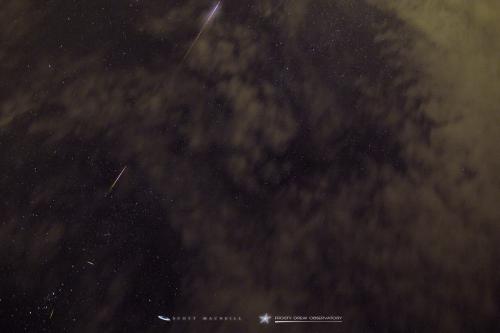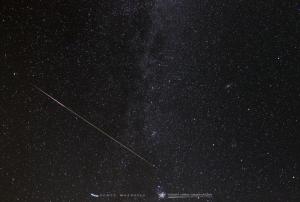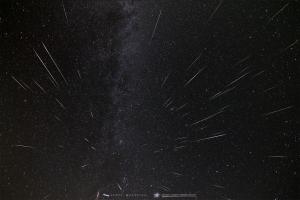Gear Up For the Perseids

A Perseid fireball through the clouds during the 2016 Perseid peak at Frosty Drew Observatory. Image credit: Frosty Drew Astronomy Team member, Scott MacNeill
This coming Wednesday night, August 11, 2021, the peak of the Perseid Meteor Shower will begin. Bringing with it an increase in regular meteor activity by upwards of 100 meteors per hour, the Perseid shower is one of the year’s best. As we have stated in the past, observing meteor showers is highly dependent on local conditions as well as celestial conditions. Most importantly, the sky needs to be as clear as possible, no clouds, no haze, and the Moon cannot be present. Timings are critical as well because the radiant point of the shower needs to be well above the horizon to see the most meteors. In 2021, we certainly have great conditions in regards to the Moon, but August is wildfire season, and smoke usually crashes the yearly meteor display. Can 2021 work to our advantage? It’s still too early to tell, but we aren’t holding our breath.
The Perseid shower is a product of a comet named 109P/Swift-Tuttle. A periodic comet with an orbital period of 133 years, Swift-Tuttle will cross Earth’s orbit during perihelion (closest to the Sun). When this happens the increasing bombardment of the solar wind against the comet causes the nucleus to heat up, resulting in the melting of ices on the comet. This process will cause particles of ice and rock to be released into a debris field along the orbital path of the comet. Most of these particles are between dust-sized – rice-sized. When Earth orbits through the debris field every August, these small particles get caught in Earth’s gravity and enter the atmosphere at rates of 37 miles per second. Once encountering the mass of Earth’s atmosphere, these particles burn up leaving a visible streak across the sky. Occasionally larger particles will enter the atmosphere, these are what creates a fireball meteor or a bolide. Which can be defined as very bright, longer lasting meteors that may fragment and result in a delayed concussive sound. Because Earth passes through this stream of meteor fragments every August, meteors will appear to radiate, in the sky, from the star Miram in the constellation Perseus. This is where the meteor shower gets its name from – the constellation of the radiant point.
Comet Swift-Tuttle is rather large, with a nucleus measuring 16 miles in diameter. The comet passes quite close to Earth during perihelion passage and was once considered a significant impact threat. During the last perihelion passage in 1992, we were able to learn a lot about the comet and refine our understanding of the comet’s orbit, removing any such threats. Though the comet will still pass VERY close to Earth during future passes, specifically in 3044 when the comet passes Earth at a distance of 994,194 miles distant. The next closest approach of Swift-Tuttle to Earth will occur on August 5, 2126 at a distance of 14.2 million miles. Certainly a lot of fodder for doomsayers!
So how should one observe the Perseid peak? Depending on your location there are a few things to keep in mind. Considering that the 15% waxing crescent Moon will set at 9:52 pm, the Moon will not interfere with your view, so you will certainly want to get out of the city and find a super dark spot with a wide open view of the sky. The best times to be out will be after midnight, during the morning hours of August 12th and, as a backup, August 13th. The Perseid radiant point is circumpolar from our latitude in Southern New England, which means that it never rises or sets, and is always above the horizon. Though it does sit rather low on the horizon at sunset and will reach 30° in altitude by midnight, becoming nearly overhead at sunrise. Looking towards the radiant point will reduce the number of meteors you see because they enter the atmosphere near that location and will brighten as they streak away from that spot. Laying on your back so you have a comfortable view of the zenith (top of sky) will be key. When laying down, orientate your feet towards the SW, and keep an eye to the zenith.
Frosty Drew Observatory and Science Center will host a special event for the Perseid Peak that starts at 8:30 pm on August 11th and August 12th. The event is dependent on weather, which is still uncertain at this point. Keep checking our event page for updates. It’s been years since we have had a good Perseid peak, with the last time being in 2015. Check out this composite of the shower we did at Frosty Drew in 2015. Perhaps this week will bring the next amazing view?
- Author:
- Scott MacNeill
- Entry Date:
- Aug 6, 2021
- Published Under:
- Scott MacNeill's Columns



